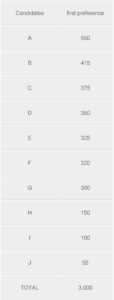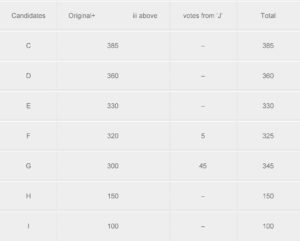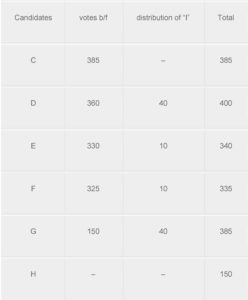ICAI election procedure
Our elections are held on the single ‘transferable vote’ system under which the voter has to indicate his preferences about the candidates by inserting the figures 1, 2, 3 etc against the names of the candidates according to his preference. Some members are under the impression that only the ‘ first’ preference vote has value. This impression is not correct.
Our elections are held on the single ‘transferable vote’ system under which the voter has to indicate his preferences about the candidates by inserting the figures 1, 2, 3 etc against the names of the candidates according to his preference. Some members are under the impression that only the ‘ first’ preference vote has value. This impression is not correct. A candidate is required to obtain only specified number of first preference for getting himself elected. If the first preference votes obtained by him are more than the required number, the excess is transferred to candidates who have secured 2nd and 3rd preferences. Similarly, if the number of the first preference votes received by received by a candidate are much below than the required number of, his first preference votes will be transferred at full value to those candidates who have been marked for subsequent preferences. It is, therefore, important to know that a voter should not select only one candidate of his choice but should select as many candidates as possible and mark his for such candidates. This will help the voter to get at least one of the candidates of his choice elected.
The procedure for counting the votes and for distribution of the proportionate value of various preferences to different candidates is somewhat complicated. An attempt has been made in the illustration given below to explain the working of this system.
ILLUSTRATION:
- No. Of candidates 10
- No. Of candidates to be selected 5
- No. Of valid votes cast 3,000
- Quota for election
3,000 x 100
—————– + 1 = 50,001
5 + 1
For the purpose of simplification the quota for this illustration is taken to be 500 votes
5. Distribution of votes:

6. First Count:
(i) Candidate ‘A’ will be declared elected as he gets more than 500 votes
(ii) Surplus of 50 votes will be distributed to other candidates. For this purpose the value of surplus votes will be worked out and distributed will be worked out and distributed to candidates who have been marked second preferences.
(iii) If only 500 out of 550 voters have exercised their second preferences, the value of each surplus vote will work out to 50 divided by 500 i.e. 10%. On distribution of second preference votes, the position of the other candidates will be as under, if these preferences are received by B, C D and E only.

On the above basis, candidate ‘B’ will be declared as elected as he gets 500 votes on distribution of surplus of ‘A’.
7. Elimination candidates:
(i) Since there are no surpluses with other candidates, the candidate who has got the lowest number of votes will be eliminated.
(ii)In the given case ‘J’ will be the first to be eliminated. 55 votes in his packet will be distributed to candidates who have been marked second or subsequent preferences at full value. If only 50 voters have marked second or subsequent preferences the distribution will be as under.

(iii) The next candidate to be eliminated will be ‘I’ with 100 votes. I all the voters have exercised subsequent preferences, the position will be as under:

(iv) The next candidate to be eliminated will be “H”. If all the 150 candidates have expressed their subsequent preferences, the position will be as under:

On this basis “D” will be declared elected and “F” who has got the least votes of 335 gets eliminated. Out of this 33 if only 275 voters have expressed their subsequent preferences the distribution will be as follows:

Here “G” gets elected.
(v) The remaining candidates will be “C” and “E”. Since the number of votes obtained by “E” is 470 as against 455 by “C”, “E” will be declared elected even though he had secured less than 500 votes.
(vi) A, B, D, G and E will be the candidates who are successful in this election.
Source : Click Here

